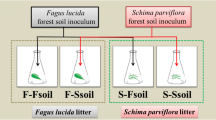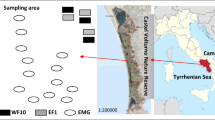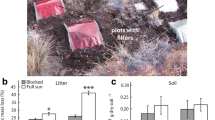Abstract
Photodegradation helps explain why leaf litter mass loss rates are comparable between mesic environments and drylands, despite water availability limiting decomposer activity in drylands. With photodegradation, light energy directly mineralizes photoreactive organic molecules such as lignin, which contrasts with biotically-driven decomposition where lignin persists in decomposing leaf litter relative to other compounds. Photodegradation of leaf litter has largely been studied in dryland systems, but whether it occurs in mesic, deciduous forest systems is uncertain. As such, we examined potential photodegradation in maple and oak litter in the Southern Appalachian Mountains (USA) during the non-growing season, when newly fallen leaves are exposed to maximum solar radiation without deciduous canopies. The proportion of oxidized lignin in the leaf litter relative to other carbon compounds decreased with maximum solar radiation during the non-growing season. With a closed canopy, however, the proportion of total lignin relative to other compounds in the leaves increased. This pattern was particularly strong for the syringyl- S6 and guaiacyl-G6 lignin monomers. The relative proportion of S6 and G6 in the litters was reduced by 10–65% in the first 5 months. The largest reductions in lignin occurred on south-facing mountain slopes where solar radiation was highest (relative to north-facing slopes) in the Northern Hemisphere. Overall, however, the changes in lignin did not alter cumulative litter mass lost. Our results suggest that photodegradation promotes the transformation and relative loss of lignin in the early stages of litter decomposition in mesic deciduous forests.



Similar content being viewed by others
Data availability
Available upon request.
Code availability
N/A
References
Adair EC, Parton WJ, King JY, Brandt LA, Lin Y (2017) Accounting for photodegradation dramatically improves prediction of carbon losses in dryland systems. Ecosphere. https://doi.org/10.1002/ecs2.1892
Austin AT, Ballare CL (2010) Dual role of lignin in plant litter decomposition in terrestrial ecosystems. Proc Natl Acad Sci USA 107(10):4618–4622
Austin AT, Vivanco L (2006) Plant litter decomposition in a semi-arid ecosystem controlled by photodegradation. Nature 442(7102):555–558
Austin AT, Méndez MS, Ballaré CL (2016) Photodegradation alleviates the lignin bottleneck for carbon turnover in terrestrial ecosystems. Proc Natl Acad Sci USA 113(16):4392–4397
Baker NR, Allison SD (2015) Ultraviolet photodegradation facilitates microbial litter decomposition in a Mediterranean climate. Ecology 96(7):1994–2003
Blair JM (1988) Nitrogen, sulfur and phosphorus dynamics in decomposing deciduous leaf litter in the southern Appalachians. Soil Biol Biochem 20(5):693–701
Bradford MA, Berg B, Maynard DS, Wieder WR, Wood SA (2016) Understanding the dominant controls on litter decomposition. J Ecol 104(1):229–238
Brandt LA, King JY, Hobbie SE, Milchunas DG, Sinsabaugh RL (2010) The Role of Photodegradation in Surface Litter Decomposition Across a Grassland Ecosystem Precipitation Gradient. Ecosystems 13(5):765–781
Collins SL, Sinsabaugh RL, Crenshaw C, Green L, Porras-Alfaro A, Stursova M, Zeglin LH (2008) Pulse dynamics and microbial processes in aridland ecosystems. J Ecol 96(3):413–420
Couteaux MM, Bottner P, Berg B (1995) Litter decomposition, climate and litter quality. Trends Ecol Evol 10(2):63–66
Esch EH, King JY, Cleland EE (2019) Foliar litter chemistry mediates susceptibility to UV degradation in two dominant species from a semi-arid ecosystem. Plant Soil 440(1):265–276
Filley TR, Cody GD, Goodell B, Jellison J, Noser C, Ostrofsky A (2002) Lignin demethylation and polysaccharide decomposition in spruce sapwood degraded by brown rot fungi. Org Geochem 33(2):111–124
Filley TR, Nierop KG, Wang Y (2006) The contribution of polyhydroxyl aromatic compounds to tetramethylammonium hydroxide lignin-based proxies. Org Geochem 37(6):711–727
Filley TR, McCormick MK, Crow SE, Szlavecz K, Whigham DF, Johnston CT, van den Heuvel RN (2008) Comparison of the chemical alteration trajectory of Liriodendron tulipifera L. leaf litter among forests with different earthworm abundance. Journal of Geophysical Research: Biogeosciences. https://doi.org/10.1029/2007JG000542
Foereid B, Bellarby J, Meier-Augenstein W, Kemp H (2010) Does light exposure make plant litter more degradable? Plant Soil 333(1):275–285
Gallo ME, Porras-Alfaro A, Odenbach KJ, Sinsabaugh RL (2009) Photoacceleration of plant litter decomposition in an arid environment. Soil Biol Biochem 41(7):1433–1441
George B, Suttie E, Merlin A, Deglise X (2005) Photodegradation and photostabilisation of wood – the state of the art. Polym Degrad Stab 88(2):268–274
Gliksman D, Rey A, Seligmann R, Dumbur R, Sperling O, Navon Y, Haenel S, De Angelis P, Arnone JA, Grünzweig JM (2017) Biotic degradation at night, abiotic degradation at day: positive feedbacks on litter decomposition in drylands. Glob Change Biol 23(4):1564–1574
Harmon ME, Silver WL, Fasth B, Chen H, Burke IC, Parton WJ, Hart SC, Currie WS, Lidet, (2009) Long-term patterns of mass loss during the decomposition of leaf and fine root litter: an intersite comparison. Glob Change Biol 15(5):1320–1338
Henry HAL, Brizgys K, Field CB (2008) Litter decomposition in a california annual grassland: Interactions between photodegradation and litter layer thickness. Ecosystems 11(4):545–554
Hothorn T, Bretz F, Westfall P (2008) Simultaneous Inference in General Parametric Models. Biom J 50(3):346–363
Keiser AD, Bradford MA (2017) Climate masks decomposer influence in a cross-site litter decomposition study. Soil Biol Biochem 107:180–187
King JY, Brandt LA, Adair EC (2012) Shedding light on plant litter decomposition: advances, implications and new directions in understanding the role of photodegradation. Biogeochemistry 111(1–3):57–81
Klotzbücher T, Filley TR, Kaiser K, Kalbitz K (2011) A study of lignin degradation in leaf and needle litter using 13C-labelled tetramethylammonium hydroxide (TMAH) thermochemolysis: Comparison with CuO oxidation and van Soest methods. Org Geochem 42(10):1271–1278
Klotzbücher T, Kaiser K, Filley TR, Kalbitz K (2013) Processes controlling the production of aromatic water-soluble organic matter during litter decomposition. Soil Biol Biochem 67:133–139
Laseter SH, Ford CR, Vose JM, Swift LW Jr (2012) Long-term temperature and precipitation trends at the Coweeta Hydrologic Laboratory, Otto, North Carolina, USA. Hydrol Res 43(6):890–901
Lehmann J, Kleber M (2015) The contentious nature of soil organic matter. Nature 528(7580):60–68
Lensing JR, Wise DH (2007) Impact of changes in rainfall amounts predicted by climate-change models on decomposition in a deciduous forest. Appl Soil Ecol 35(3):523–534
Lin Y, King JY (2014) Effects of UV Exposure and Litter Position on Decomposition in a California Grassland. Ecosystems 17(1):158–168
Lin Y, King JY, Karlen SD, Ralph J (2015) Using 2D NMR spectroscopy to assess effects of UV radiation on cell wall chemistry during litter decomposition. Biogeochemistry 125(3):427–436
Ludwig M, Achtenhagen J, Miltner A, Eckhardt K-U, Leinweber P, Emmerling C, Thiele-Bruhn S (2015) Microbial contribution to SOM quantity and quality in density fractions of temperate arable soils. Soil Biol Biochem 81:311–322
Manzoni S, Schimel JP, Porporato A (2012) Responses of soil microbial communities to water stress: results from a meta-analysis. Ecology 93(4):930–938
Mason SL, Filley TR, Abbott GD (2009) The effect of afforestation on the soil organic carbon (SOC) of a peaty gley soil using on-line thermally assisted hydrolysis and methylation (THM) in the presence of 13C-labelled tetramethylammonium hydroxide (TMAH). J Anal Appl Pyrol 85(1):417–425
Meentemeyer V (1978) Macroclimate and lignin control of litter decomposition rates. Ecology 59(3):465–472
Nierop KGJ, Filley TR (2007) Assessment of lignin and (poly-)phenol transformations in oak (Quercus robur) dominated soils by 13C-TMAH thermochemolysis. Org Geochem 38(4):551–565
Opsahl S, Benner R (1998) Photochemical reactivity of dissolved lignin in river and ocean waters. Limnol Oceanogr 43(6):1297–1304
Parton W, Silver WL, Burke IC, Grassens L, Harmon ME, Currie WS, King JY, Adair EC, Brandt LA, Hart SC, Fasth B (2007) Global-scale similarities in nitrogen release patterns during long-term decomposition. Science 315(5810):361–364
Pieristè M, Chauvat M, Kotilainen TK, Jones AG, Aubert M, Robson TM, Forey E (2019) Solar UV-A radiation and blue light enhance tree leaf litter decomposition in a temperate forest. Oecologia 191(1):191–203
Pinheiro J, Bates D, DebRoy S, Sarkar D, Team RC (2017) nlme: Linear and Nonlinear Mixed Effects Models. In., http://CRAN.R-project.org/package=nlme.
Schaefer D, Steinberger Y, Whitford WG (1985) The failure of nitrogen and lignin control of decomposition in a North American desert. Oecologia 65(3):382–386
Searles PS, Flint SD, Díaz SB, Rousseaux MC, Ballaré CL, Caldwell MM (2002) Plant response to solar ultraviolet-B radiation in a southern South American Sphagnum peatland. J Ecol 90(4):704–713
Sokol NW, Sanderman J, Bradford MA (2019) Pathways of mineral-associated soil organic matter formation: Integrating the role of plant carbon source, chemistry, and point of entry. Glob Change Biol 25(1):12–24
Song X, Peng C, Jiang H, Zhu Q, Wang W (2013) Direct and indirect effects of UV-B exposure on litter decomposition: a meta-analysis. PLoS ONE 8(6):e68858–e68858
Talbot JM, Yelle DJ, Nowick J, Treseder KK (2012) Litter decay rates are determined by lignin chemistry. Biogeochemistry 108(1):279–295
Team RC (2018) R: A language and environment for statistical computing. In. R Foundation for Statistical Computing, Vienna, Austria.
Uselman SM, Snyder KA, Blank RR, Jones TJ (2011) UVB exposure does not accelerate rates of litter decomposition in a semi-arid riparian ecosystem. Soil Biol Biochem 43(6):1254–1265
Wang J, Liu L, Wang X, Chen Y (2015) The interaction between abiotic photodegradation and microbial decomposition under ultraviolet radiation. Glob Change Biol 21(5):2095–2104
Wang R, Gibson CD, Berry TD, Jiang Y, Bird JA, Filley TR (2017) Photooxidation of pyrogenic organic matter reduces its reactive, labile C pool and the apparent soil oxidative microbial enzyme response. Geoderma 293:10–18
Wysocki LA, Filley TR, Bianchi TS (2008) Comparison of two methods for the analysis of lignin in marine sediments: CuO oxidation versus tetramethylammonium hydroxide (TMAH) thermochemolysis. Org Geochem 39(10):1454–1461
Acknowledgements
Funding was from the USDA Forest Service, the National Science Foundation, and the U.S. Environmental Protection Agency through a STAR Fellowship to ADK. EPA has not formally reviewed this publication, and the views expressed herein may not reflect the views of the EPA. We thank Avishesh Neupane for help in the lab, and Emily Oldfield for help in the field. We also thank two anonymous reviewers for their improvements to the manuscript.
Funding
USDA Forest Service, the National Science Foundation, and the U.S. Environmental Protection Agency through a STAR Fellowship to ADK.
Author information
Authors and Affiliations
Corresponding author
Ethics declarations
Conflict of interest
N/A
Additional information
Responsible Editor: Stephen D. Sebestyen.
Publisher's Note
Springer Nature remains neutral with regard to jurisdictional claims in published maps and institutional affiliations.
Supplementary Information
Below is the link to the electronic supplementary material.
Rights and permissions
About this article
Cite this article
Keiser, A.D., Warren, R., Filley, T. et al. Signatures of an abiotic decomposition pathway in temperate forest leaf litter. Biogeochemistry 153, 177–190 (2021). https://doi.org/10.1007/s10533-021-00777-9
Received:
Accepted:
Published:
Issue Date:
DOI: https://doi.org/10.1007/s10533-021-00777-9




